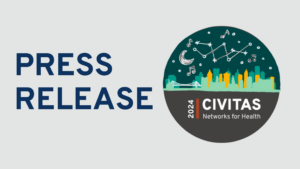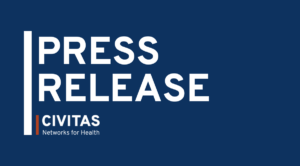Guest Blog Post by: Waldo Mikels-Carrasco, Data Across Sectors for Health in partnership with Jolie Ritzo, Civitas Networks for Health
Health data exchange has evolved greatly since its inception in the early 2000s. As use cases have expanded, health information exchanges (HIEs), health data utilities (HDUs), and other health data collaboratives have improved efficiency of care coordination and information-sharing among patients, medical providers, payers, and public health, and other agencies. Though these data exchange-focused entities do not deliver care, they contribute to improved care, lowering costs and access barriers.
Initiatives like the Veteran Administration’s Whole Health Initiative are helping redefine medical care to encompass whole-human wellbeing. Both the CDC and the US Department of Health and Human Serviceshave pivoted their work to consider social determinants of health (SDOH) to be key indicators of health and health equity. As more providers and agencies move into delivering whole-person care, it is necessary to go beyond disease reporting and look for other data points that indicate a person’s well being. Collaborators like Gravity Project are leading the development of SDOH standards to allow for integration of critical data that highlights unmet health related social needs and that coordinates services beyond health care settings.
The infrastructure supporting whole-human health and well-being requires multisector data sharing. Because community-based organizations (CBOs) are often closer to patients’ communities and help develop a holistic understanding of the community, the patient voice is better represented, and sustainable patient health and wellbeing are more achievable when CBOs are in the health data collaboration. Community care hubs (CCH), which can assist in social care and community care coordination, are one way to fulfill this important role.
This is a powerful approach for improving health outcomes—and a challenging one to implement. Health data collaboratives are generally set up to share clinical data within the health care sector. Human services CBOs are typically meant to respond to a specific, local social need. CCHs and regional health improvement collaboratives can serve as neutral convenors and help to bring various stakeholders and sectors together.
The crux of the challenge is that you cannot engage in cross-sector data sharing without establishing a trusted relationship first. Civitas and its members are deeply committed to community-centric data sharing and governance. Our goal is to bridge data and doing and to be sure community partners across stakeholders are at the table.
Civitas member Data Across Sectors for Health (DASH) has supported hundreds of multisector collaborations in developing data-sharing practices since 2016, including several with HIEs as partners. As this case study and other DASH-supported initiatives demonstrate, multisector data sharing that improves patient success is built not solely on technical management but on partnership and trust between providers and between providers and the communities they serve.
DC PACT (Positive Accountable Community Transformation) in Washington, D.C., is a coalition effort of community providers in partnership with government agencies. DC PACT received DASH’s 2020 Learning and Action in Policy and Partnerships (LAPP) grant to build out its screening, referral, and look-up services component, called CoRIE.
Key activities that support this success:
- Build on existing partnerships using proven collaboration models: To build capacity, the DC PACT used collective impact, a model for tackling complex social problems as a coalition. The coalition’s administrative “backbone organization” is DC PCA (Primary Care Association), a longstanding and trusted health equity organization in the District of Columbia. Partners include more than 30 non-government organizations (CBOs, religious organizations, clinics and so on) and multiple district and regional agencies that address the various social determinants of health and related needs and services.
- Secure the right kind of support from government agencies and government funders: The District of Columbia government was on board and had already invested fully in developing an HIE, called DC CRISP. DC Medicaid, called DHCF, was essential for funding. These entities were willing to resource the initiative for its multi-year build-out and continuing operation, while also trusting the coalition organizations to do the planning. Implementation, and management of the work.
- Give it time: Coalition building started in 2016 with trust-building and dedicated work on commitments, common agendas and goals, communication protocols, and shared community health and wellness metrics so all parts of the process would be understood the same by all involved and evaluated appropriately. Only then did technical infrastructure begin, in 2020.
- Build on existing technical capabilities: The coalition made a point to start with what was already working for people on the ground. They built their technical infrastructure on existing capabilities rather than installing an out-of-the-box solution or custom-building from scratch. Optimizing current workflows made for quick wins that could gain buy-in and build partnerships, and then targeted third-party solutions could be used to fill in where needed. Technical needs were vendor agnostic so various stakeholders could continue using the systems they already used.
Health data sharing is no longer just for those in health care. To achieve whole-person care, we must work collaboratively with community-based organizations and social service providers to expand the governance structure and build critical community partnerships. The DASH Framework offers a visual understanding of the requirements for an equitable data ecosystem shared across sectors.
Establishing partnerships and shared governance practices takes time, trust, and a shared vision that the hard work of creating these foundations will be meaningful. Funders can aid this process by funding the foundational work of coalition-building infrastructure, not just the work of production, and by providing the time, space, and resources during implementation for evolution and iteration.



